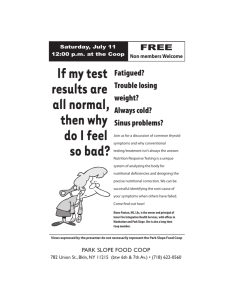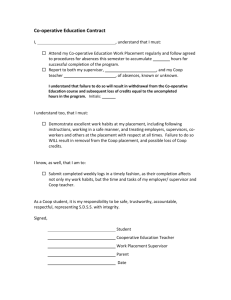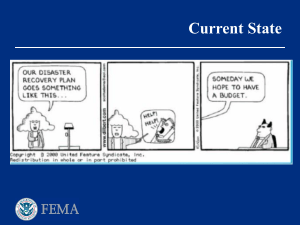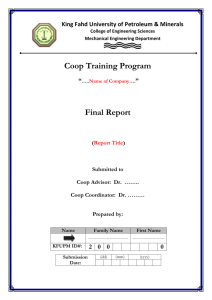Loyalty, Exit and Enforcement: Evidence from a Kenya Dairy Cooperative By L *
advertisement
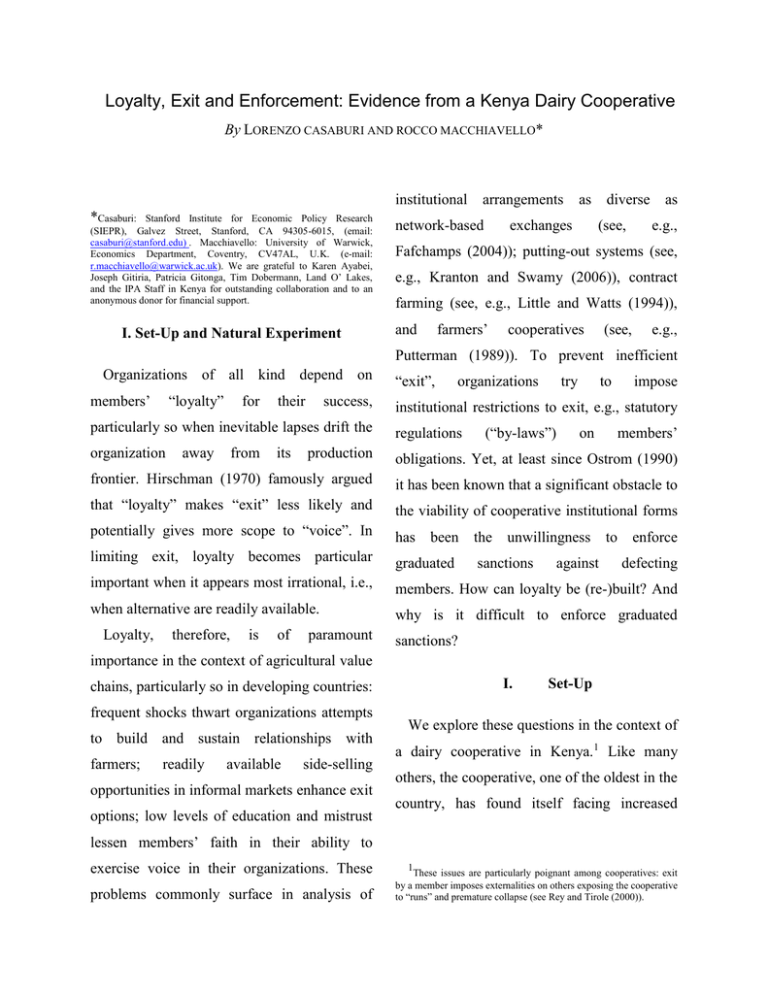
Loyalty, Exit and Enforcement: Evidence from a Kenya Dairy Cooperative By LORENZO CASABURI AND ROCCO MACCHIAVELLO* institutional *Casaburi: Stanford Institute for Economic Policy Research (SIEPR), Galvez Street, Stanford, CA 94305-6015, (email: casaburi@stanford.edu) . Macchiavello: University of Warwick, Economics Department, Coventry, CV47AL, U.K. (e-mail: r.macchiavello@warwick.ac.uk). We are grateful to Karen Ayabei, Joseph Gitiria, Patricia Gitonga, Tim Dobermann, Land O’ Lakes, and the IPA Staff in Kenya for outstanding collaboration and to an anonymous donor for financial support. I. Set-Up and Natural Experiment arrangements network-based as exchanges diverse (see, as e.g., Fafchamps (2004)); putting-out systems (see, e.g., Kranton and Swamy (2006)), contract farming (see, e.g., Little and Watts (1994)), farmers’ and cooperatives (see, e.g., Putterman (1989)). To prevent inefficient Organizations of all kind depend on members’ “loyalty” for their success, “exit”, organizations try to impose institutional restrictions to exit, e.g., statutory particularly so when inevitable lapses drift the regulations organization production obligations. Yet, at least since Ostrom (1990) frontier. Hirschman (1970) famously argued it has been known that a significant obstacle to that “loyalty” makes “exit” less likely and the viability of cooperative institutional forms potentially gives more scope to “voice”. In has limiting exit, loyalty becomes particular graduated important when it appears most irrational, i.e., members. How can loyalty be (re-)built? And when alternative are readily available. why is it difficult to enforce graduated Loyalty, away from therefore, is its of paramount (“by-laws”) been the on unwillingness sanctions against members’ to enforce defecting sanctions? importance in the context of agricultural value I. chains, particularly so in developing countries: frequent shocks thwart organizations attempts to build and sustain relationships with farmers; readily available side-selling opportunities in informal markets enhance exit options; low levels of education and mistrust Set-Up We explore these questions in the context of a dairy cooperative in Kenya.1 Like many others, the cooperative, one of the oldest in the country, has found itself facing increased lessen members’ faith in their ability to exercise voice in their organizations. These problems commonly surface in analysis of 1 These issues are particularly poignant among cooperatives: exit by a member imposes externalities on others exposing the cooperative to “runs” and premature collapse (see Rey and Tirole (2000)). competition for milk supply. Milk is produced afternoon during the previous months. At that by farmers twice a day: in the morning and in time, the coop had 1,754 active members, the afternoon. Administrative records from the among which 1,080 that did not deliver any coop reveal that many members sell part of milk during the previous month (henceforth, their milk to local traders: while they sell “target members”). In total, 529 members regularly to the cooperative in the morning, attended the assembly. Among the target they sell none of their afternoon production. members, 742 received the letter and 361 Yet, selling to local traders is a violation of attended the assembly (263 did both). coop’s by-laws: farmers are supposed to sell II. Results all their produce in excess of household consumption to the coop.2 Following a We explore how deliveries to the coop deteriorating financial changed after the assembly and the letter using performance, the management of the coop has detailed milk delivery data to the coop and an set out to explore ways of increasing milk original survey of non-compliant farmers deliveries and re-enhancing members’ loyalty. conducted after the assembly and the letter. In February 2014 the issue of afternoon milk We implement a DID specification that deliveries was discussed at the general includes both day and farmer fixed effects and members’ assembly (henceforth, “assembly”). examine different margins of response. We At the meeting, the by-laws provision focus on how member responded to the according to which all milk in excess of announcement that the coop would implement domestic consumption must be sold to the penalties. We find three main results: i) the coop was vigorously re-stated and the announcement induced some members to “graduated increase deliveries; ii) it also led other sanctions” as specified in the by-laws would members to stop delivering milk (“exit”); iii) be implemented. Those include financial the two components of the treatment – the penalties, refusal to purchase milk and assembly and the letter – are substitute. management announced that expulsion from the coop. Following the A. Positive Effects meeting, a letter was also sent, mostly to members who did not deliver milk in the We begin by considering an ITT specification in which the focus is on target 2 Many traders are also illegal and operate without required license posing potentially serious hazard to consumers. members (i.e., those not supplying milk in the afternoon session during January 2014), Table 1 presents the DID specification. irrespective of whether they received the letter Column (1) focuses on daily deliveries and and/or The shows that average afternoon deliveries go up announcement generated a positive response by 0.333 liters in the target group. Column (2) among some of those target members. Figure aggregates the data in four 30-day periods (2 1 presents evidence of this. The dark dots before the announcement and 2 afterwards). It display the share of members delivering in the shows that the likelihood that the farmer sells afternoon among the target members. Over the to the coop at least 15 days in the period goes weeks immediately after the meeting, about up by 17.1 percentage points among the target 20% of these members start selling to the group after the announcement. attended the assembly. coop. The light dots show the share of B. Exit vs. Gaming members selling in the afternoon among the remaining active members, i.e. those who sold The results confirm that the announcement did at least once in the afternoon in January 2014. induce some target members to sell to the This likelihood is constant over the sample coop in both daily sessions. Column (3) in period. The differential response persists for Table 1, however, shows a reduction in several months after the announcement. 3 FIGURE 1: SHARE OF MEMBERS DELIVERING MILK IN THE AFTERNOON morning deliveries for targeted farmers, relative to non-targeted ones, albeit nonsignificant at conventional levels. By combining the point estimates of Column (1) and (3), the announcement generated a small increase in daily deliveries (am+pm) among the target members, non-significant at conventional levels. Column (4) provides Notes: The dark scatter shows the daily share of “targeted” members delivering milk to the coop in the afternoon. The light scatter shows the share of “non-targeted” members delivering milk to the coop in the afternoon. Targeted members are those who did not deliver milk in the afternoon in January 2014.The vertical line is placed at the general assembly date (Feb 11, 2014). evidence of a large and significant decline on the extensive margin: the likelihood of not delivering milk in the morning goes up by 7.8 percentage points, from a baseline mean of 16.7. 3 The timing of the response rules out mean-reversion as an explanation for the delivery pattern. TABLE 1: DIFFERENCE-IN-DIFFERENCES ON COOP MEMBER DELIVERY OUTCOMES Notes: The table reports the coefficient 𝛽 from the following regression equation: 𝑦𝑖𝑡 = 𝜃𝑖 + 𝜃𝑡 + 𝛽𝑃𝑜𝑠𝑡𝑡 ∗ 𝑇𝑎𝑟𝑔𝑒𝑡𝑖 + 𝜀𝑖𝑡 , where 𝑦𝑖𝑡 is the outcome variable for farmer i in period t. The row Sample describes the frequency of the observations for each outcome variable (daily or monthly). A description of each outcome variable is provided in the text. The indicator Post equals one if the observation refers to a period (day, month) after the cooperative general assembly (February 11, 2014). The indicator Target equals one if the coop member did not delivery any milk in the afternoon in January 2014 and was thus targeted by the announcement at the meeting. Standard errors are clustered at the coop member level ***, **, * Significant at the 1, 5 and 10 percent level, respectively. This change may be driven by two different monthly level confirms these results: Column responses: “gaming” and “exit”. In the former, (8) shows that the announcement increases some members switch from delivering in the significantly the share of target members who morning to delivering in the afternoon to deliver milk to the coop less than 15 days per avoid the penalties. In the latter, members stop month. This negative exit effect is permanent. delivering altogether, de facto leaving the To summarize, the announcement of organization. Column (5) suggests only graduated sanctions against members not moderate gaming: the likelihood that the delivering in the afternoon had heterogeneous target members deliver milk to the coop only effects: some members positively responded in the afternoon goes up differentially by 1.4 increasing deliveries; others “exited” and percentage points relative to the non-target reducing their morning deliveries. members in the post period. The analysis C. Engagement when aggregating deliveries at the monthly level confirms this pattern (Column (6)). We To better understand this heterogeneity, we find stronger evidence of “exit”. Column (7) explore differential effects within the group of shows that, following the announcement, the targeted members. We are interested in likelihood of no-delivery in any given day understanding if the effect is larger for more increases by 6.5 percentage points for target engaged members (as implied by Hirschman’s members (relative to non-target ones). In other argument) and whether the letter reinforces or words, “exit” explains 83% of the decline in dilute the effects of members’ engagement. morning deliveries reported in Column (4). The announcement that sanctions would be The analysis of aggregate deliveries at the enforced was delivered through i) the assembly and, ii) the letter. Here, we look at social behavior, we conjecture the letter the impact and interaction of these two crowded out the intrinsic motivation of more strategies. As caveats to a causal interpretation engaged members (see, e.g., Benabou and of the results, note that i) the choice to attend Tirole (2006)). The threat of sanctions is, the meeting may be correlated with other nevertheless member-level unobservables and ii) criteria farmers. effective on less engaged the coop used to select the letter recipients are III. Why is it Difficult to Enforce Threats? not fully transparent. We restrict the sample to target members It turns out that the cooperative never and use a DID with farmer and day fixed enforced the threatened sanctions on non- effects as above. We split the target members delivering members. As famously illustrated into four groups and focus on afternoon by Ostrom (1990), our cooperative is far from deliveries. Relative to those who did not being unique in this respect. Why is it so attend the assembly and did not receive the difficult to enforce threats, even when they are letter, we find that: i) those who attended the written in formal by-laws? assembly and did not receive the letter increase deliveries kilograms survey we conducted among farmers few (SE=0.21, p-value=0.002) from a baseline months after the assembly and the letter were mean of 0.034; ii) those who received the sent. We focus on farmers that were still not letter and did not attend the assembly increase complying with the by-laws. We argue that a afternoon kilograms key challenge in enforcing threats comes from (SE=0.097, p-value=0.019); iii) those who heterogeneous beliefs among members on the both attended and received the letter increased legitimacy of those threats. This evidence delivery by 0.29 kilograms (SE=0.105, p- echoes recent work on the importance of value=0.005). In sum, the evidence confirms clarity in managing and sustaining relational Hirschman’s logic that the effect of the contracts announcement was stronger on more engaged (2013)). deliveries by by 0.64 Some suggestive evidence comes from a 0.23 (see Gibbons and Henderson farmers, i.e., those who attended the assembly. Among those farmers who did not respond Moreover, there is some evidence that the to the threat of sanctions, we asked “Do you letter dilutes the effect among engaged think the coop should take actions against farmers. Following a recent literature on pro- members that hawk milk?” We find that 64% of respondents say that coop should not punish also are more likely to report that a bonus members who hawk.4 Among those who say would be more effective at increasing the coop should punish, 46% say the coop deliveries from members than the penalties should fine these members; 41% the coop stated in the by-laws. should expel members; 30% the coop should IV. Conclusions refuse to buy milk (all these sanctions are part of the by-laws). Studying a cooperative’s attempt to increase These differences in beliefs are likely to deliveries by members, we have shown what reflect differences in attitudes towards the the threat of sanctions leads to highly coop management rather than differences in heterogeneous response among members. information. Farmers stating the coop should While some members “exit”, other members not act against defecting members do not increase appear to be less informed about provisions in cooperative the by-laws and are equally likely to report to threatened sanctions, we find positive effects have read them. 5 Perhaps more tellingly, farmers against sanctions i) report lower levels their not deliveries. Despite the actually enforcing the that persist for several months.7 Surveying non-compliant members, we of trust in the coop board members (but not in discuss other coop members, nor in generic trust); ii) organizations might fail to enforce threats and are significantly more negative in eight out of apply sanctions that would benefit members as 6 ten questions about coop management. They suggestive evidence for why a whole: heterogeneity in beliefs about the legitimacy of those sanctions. This highlights 4 Reasons given are that members should be free to sell their milk and that the coop pays prices lower than traders. 5 We asked six true/false questions to assess farmers’ knowledge of coop’s by-laws. Farmers against sanctions are more likely to answer they do not know the answer to the question. However, conditional on answering, there is no difference in response. Note that in four out of the six questions, respondents are essentially equally split between “true” and “false”. In the two questions in which respondents are not split, the majority of respondents got the answer wrong in one of the two questions. Being not able to respond is hardly a sign of less information in this case. 6 The questions are adapted from standard workplace satisfaction questionnaires: 1. Coop management is competent in doing its job; 2. I am satisfied with services provides by the coop; 3. Coop has communicated effectively strategy, rules and procedures; 4. Milk collector is fair to me; 5. It is very important that all members attend the general annual meeting; 6. Coop management shows enough interest in the needs of their members; 7. Services provided by the coop are distributed equitably among members; 8. I feel a sense of pride in selling milk to the coop and being a member; 9. Small members are adequately represented. 10. Coop is financially the crucial role played by managers in sustaining relational contracts. In particular, it echoes recent developments in the relational contract literature about the role of clarity in defining what parties are supposed to do and sustainable. Tellingly, only 4 and 5 are not different across the two groups. 7 The persistent positive effects likely arise from changes in members’ perceptions of the coop engagement and attempts to improve while the negative ones arise from exit. There is no evidence that effects vanish over time for members surrounded by noncompliers, nor are they likely to arise from rescinding valuable relationships with traders. how they are supposed to react to defections. Kranton, R., and A. V. Swamy. (2008). An important role of managers, then, is to “Contracts, hold-up, and exports: textiles communicate to members the sources of value and opium in colonial India”. The American generated by the organization. In companion Economic Review, 967-989. research (Casaburi and Macchiavello (2014)), Little, P. D., and Watts, M. (Eds.). we show that one key source of value created (1994). Living under contract: contract by the coop is the ability to credibly promise farming and agrarian transformation in deferred payments to members and explore sub-Saharan Africa. Univ of Wisconsin the implications for market structure and coop Press. strategy of the resulting inter-linkages. Ostrom, E. (1990). Governing the commons: The evolution of institutions for collective V. REFERENCES action. Cambridge university press. Bénabou, R., & Tirole, J. (2006). Incentives and Prosocial Behavior. The American Putterman, L. (1989) “Agricultural Producer Cooperatives” in Bardhan, P. K. (Ed.). The economic theory of agrarian institutions. Economic Review, 1652-1678. Casaburi, L. and R. Macchiavello. (2014) “Saving Constraints, Reputation and Market Oxford: Clarendon Press. Rey, P., & Tirole, J. (2000). “Loyalty and Interlinkages: Evidence from the Kenya investment Dairy Industry”, mimeo Stanford Institut d'Économie Industrielle (IDEI), Fafchamps, M. (2004). Market institutions in sub-Saharan Africa: Theory and evidence. MIT Press Books, 1. Gibbons, R., and R. Henderson (2013). “What do managers do?” in R. Gibbons and J. Roverts (Eds.) Handbook of Organizational Economics, Princeton University Press, Princeton, NJ. Hirschmann, A. O. (1970). Exit, voice and loyaty: responses to decline in firms, organizations University Press. and states. Harvard Toulouse. in cooperatives” (No. 123).
